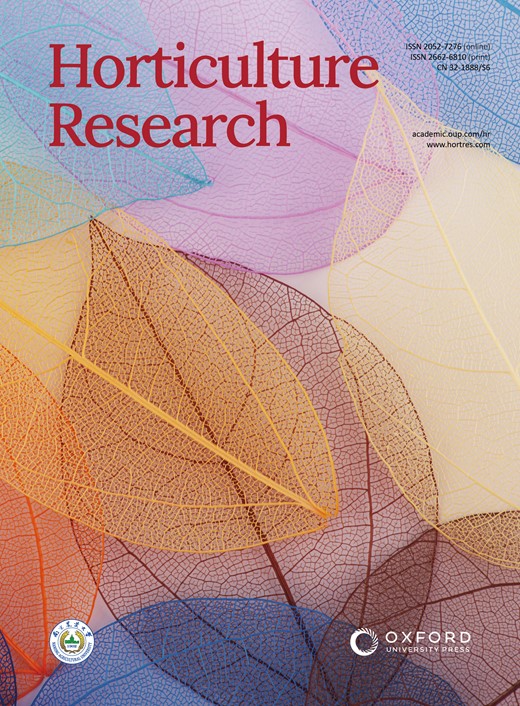在细菌中发现双功能二萜环化酶/合成酶证明植物萜合成酶基因家族起源于细菌
IF 8.7
1区 农林科学
Q1 Agricultural and Biological Sciences
引用次数: 0
摘要
陆生植物是众所周知的萜类化合物生产者,在植物与环境的相互作用中发挥着多种作用。萜类化合物的化学多样性是由萜烯合成酶引发的。植物含有一个独特的中型萜烯合成酶基因家族,称为 TPS,该家族似乎起源于细菌 I 类(二)萜烯合成酶(TS)和 II 类二萜环化酶(DTC)的融合,分别对应于催化相关的 α-二域和βγ-二域。然而,虽然在植物(和真菌)中已经发现了这种融合的三叉域双功能(I/II 类)二萜环化酶-合成酶(DCSs),但在细菌中却没有发现任何实例,因此引发 TPS 基因家族的融合事件的起源并不清楚。本文报告了在细菌中发现这种三膜双功能 DCS 的情况。通过广泛的基因组挖掘,发现了五种推定的细菌 DCS,其中三种的生化特征显示了预期的双功能活性。最引人关注的是 CseDCS,它能产生植物激素生物合成过程中的中间体--ent-kaurene,因为这正是假设的祖先 TPS 的活性。与现存的功能等同的 TPS 不同,CseDCS 有可能被拆分成独立作用的 DTC 和 TS,前者产生预期的烯丙基二磷酸(CPP),作为 CPP 合成酶(CPS),而后者将其转化为 ent-kaurene,作为 kaurene 合成酶(KS)。然而,序列比对和突变分析表明,这种蓝藻融合 CPS-KS 与功能等同的 TPSs 之间存在着惊人的相似性。不管两者之间的确切关系如何,在细菌中发现融合的双功能 DCS 支持了植物 TPS 家族起源于这种细菌基因的假设。本文章由计算机程序翻译,如有差异,请以英文原文为准。
Discovery of bifunctional diterpene cyclases/synthases in bacteria supports a bacterial origin for the plant terpene synthase gene family
Land plants are well known producers of terpenoids that play diverse roles in plant-environment interactions. The vast chemical diversity of terpenoids is initiated by terpene synthases. Plants contain a distinct mid-sized terpene synthase gene family termed TPS, which appears to have an ancient origin in a fused bacterial class I (di)terpene synthase (TS) and class II diterpene cyclase (DTC), corresponding to the catalytically relevant α-domain and βγ-didomains, respectively. However, while such fused tridomain bifunctional (class I/II) diterpene cyclases-synthases (DCSs) have been found in plants (and fungi), no examples have been reported from bacteria, leaving the origin of the fusion event initiating the TPS gene family opaque. Here, discovery of such tridomain bifunctional DCSs in bacteria is reported. Extensive genome mining unearthed five putative bacterial DCSs, with biochemical characterization revealing the expected bifunctional activity for three. Most intriguing was CseDCS, which produces ent-kaurene, an intermediate in plant hormone biosynthesis, as this is the hypothesized activity for the ancestral TPS. Unlike the extant functionally equivalent TPSs, it was possible to split CseDCS into separate, independently acting DTC and TS, with the first producing the expected ent-copalyl diphosphate (CPP), serving as a CPP synthase (CPS), while the second converts this to ent-kaurene, serving as a kaurene synthase (KS). Nevertheless, sequence alignment and mutation analysis revealed intriguing similarities between this cyanobacterial fused CPS-KS and the functionally equivalent TPSs. Regardless of exact relationship, discovery of fused bifunctional DCSs in bacteria supports the hypothesized origin of the plant TPS family from such a bacterial gene.
求助全文
通过发布文献求助,成功后即可免费获取论文全文。
去求助
来源期刊

Horticulture Research
Biochemistry, Genetics and Molecular Biology-Biochemistry
CiteScore
11.20
自引率
6.90%
发文量
367
审稿时长
20 weeks
期刊介绍:
Horticulture Research, an open access journal affiliated with Nanjing Agricultural University, has achieved the prestigious ranking of number one in the Horticulture category of the Journal Citation Reports ™ from Clarivate, 2022. As a leading publication in the field, the journal is dedicated to disseminating original research articles, comprehensive reviews, insightful perspectives, thought-provoking comments, and valuable correspondence articles and letters to the editor. Its scope encompasses all vital aspects of horticultural plants and disciplines, such as biotechnology, breeding, cellular and molecular biology, evolution, genetics, inter-species interactions, physiology, and the origination and domestication of crops.
 求助内容:
求助内容: 应助结果提醒方式:
应助结果提醒方式:


